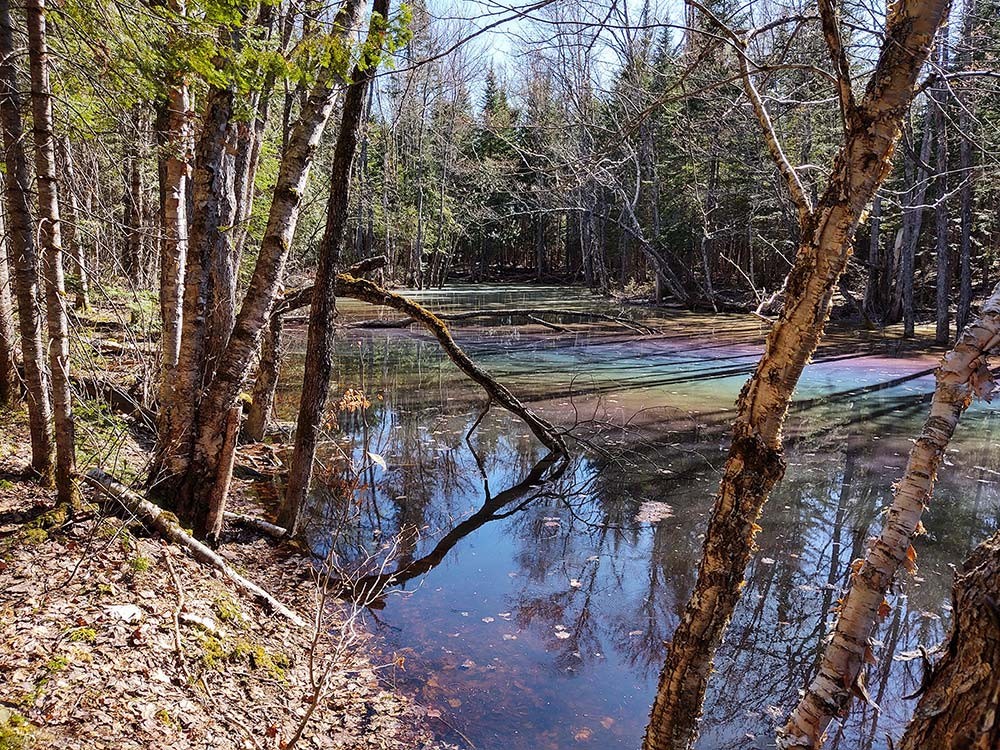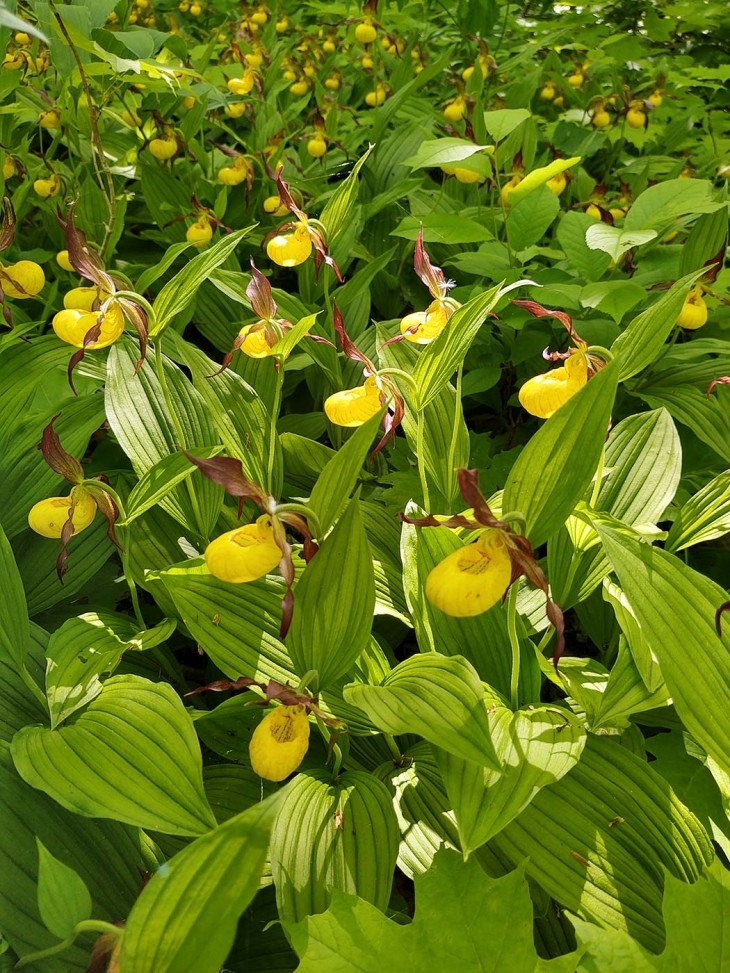
From the time he was a small child, Craig Troeger knew he wanted to tend his own land. He bought his first property – 83 acres in Van Buren, Maine – in 1974, at the age of 19. Since then, he’s added parcels as they’ve become available, growing that original plot to a total of 1,930 acres, which he and wife Nancy Troeger call Tearmunn Hardwoods. Van Buren is about as far north as you can go in the United States and is just across the St. John River from New Brunswick.
“I looked at about a dozen properties before I landed on that initial 83 acres,” said Troeger, who noted that shopping for land in 1974 involved mailing letters of inquiry to realtors. “I wanted to be at the end of a town-owned road, up against the big woods, and not with a farm field on the other side. I didn’t want to own an island of forest.”
Troeger said the property has never been farmed, with the exception of two patches where a previous owner grew potatoes. There’s a clearing of roughly 10 acres around the house where the couple lives – off the grid, powered by solar energy – and he also mows a 40-acre field. The rest of the land, including some areas that were “rather brutally high graded” at various times by former owners, is forested.
“One of the things that is very special about this place is the concentration of diverse habitat types,” he said. That includes scores of vernal pools – Troeger estimates roughly one pool for every 20 acres and said, “Probably a lot of forest managers would consider that a monumental headache for regulatory reasons, but we’re just thrilled because of the biodiversity that comes with such a piece of ground.”
Of the 1,930 acres Craig and Nancy own and manage, 1,785 of them are protected by three conservation easements. The Forest Society of Maine holds two of these as working forest easements. The third is a forever-wild easement held by the U.S. Fish & Wildlife Service.
“That came with one piece of land we bought,” Troeger said of the forever-wild easement. “It’s where the brook that flows into the Van Buren Reservoir leaves the property. It’s a steep-sided cedar seep. The stream at the bottom is a braided trout stream. It really is a special place, and it’s completely deserving of that level of protection. It’s attached to the Aroostook National Wildlife Refuge.”
While motorized public use is prohibited at Tearmunn Hardwoods, most of the land is open to hunting, fishing, and foot traffic.
Both Craig and Nancy are foresters, although Craig jokes that he’s “a biologist masquerading as a forester.” Still, managing this property has been his focus for close to five decades. Nancy, meanwhile, currently works as the town manager for Van Buren, following stints as a high school teacher and town librarian.
“Initially we gave it a shot – the two of us working in the woods together,” Troeger said. “It didn’t take long for us to figure out that one of us needed to have a job that was not ruled by physical health, weather, mechanical quirks, et cetera.”
In 2007, the Troegers developed a short document outlining their management objectives for the land. “It’s nothing that we had to do,” Troeger said. “We felt we needed some clear statement of our guiding principles. It’s now part of the easements and our management plans. It’s for us and for our successors, too.”
These guiding principles include “managing the land…to maintain, enhance, and protect its natural ecosystems and all their components, while at the same time producing a continuous and varied stream of goods and opportunities desired by human society.” According to the management objectives, “We emulate natural processes, with the hope of shaping a forest more similar to what might exist here absent past abuse and exploitation.”
While Troeger’s vision of land management has stayed true to his initial ideas, his practices have evolved over the years.
“Initially I was much more of a romantic, more of a purist than I am now, and wanted to do as much as I could ‘the old way,’” he said. “I quickly figured out that I was not going to be able to do anything on a meaningful scale on my long list of things I wanted to achieve if I continued moving wood with a pulp hook and a 1946 farm tractor.”
While he still does most of the timber stand improvement work on his own, working with his 1970 skidder, he has accepted some mechanical harvests, as well. He also tries to incorporate shifts in the wood products market into his management planning.
“Markets change and have changed a lot in the past few decades. We’ll use popple as an example – the classic quaking aspen, big-toothed aspen, and balm of Gilead (also called black popple). When I first started, the Maine Forest Service recommendation was to girdle it, to kill it in place,” he said. “Fortunately, I didn’t get very far with that before the Huber mill opened nearby in Easton. Suddenly, there was a lucrative commercial market for those three species. That could happen again with something else we might regard now as a junk wood species with no market.”
While firewood is Troeger’s “bread and butter,” he’s diversified into various other markets. The popple goes to the Easton mill. Softwood logs mostly go to an Irving mill across the river in New Brunswick. And when he occasionally harvests hardwood veneer logs, those go to Columbia Plywood in Presque Isle.
“We eliminate a lot of the management expense that a more typical, nonindustrial landowner bears,” Troeger said. “We own the land, I run the chainsaw, I run the skidder, I have a firewood processor, I truck the wood – the firewood, at least – and I’m a licensed forester, so I write the prescription.”
Like many forest managers, Troeger struggles with beech. He’s worked tirelessly to thin beech stands to remove trees affected by beech bark disease, but considers the prolifically-sprouting species to be the “biggest threat to biodiversity” on the land. Even so, he laments its predicted demise with the inevitable arrival of beech leaf disease. He’s already seen blister rust decimate pine on this property, and emerald ash borer is creeping ever closer.
With the decline of many native tree species, Troeger is already working to encourage northern red oak to grow here.
“Historically this area is north of good oak range, although there are native oaks around in special environments where the harsh climate is tempered by southern exposure or proximity to water bodies,” he said. “The climate has actually moderated enough that oaks will thrive, without having to be in a special site. So instead of waiting for the squirrels and the blue jays to move the acorns around, I have friends who are collecting acorns for me from trees of known provenance, and I’ve been planting those acorns to try to get a jump on this.”
Now in his 60s, Troeger said his pace is slowing a bit: “I’m doing timber stand improvement work on fewer acres every year, so the forest is getting ahead of me. Nature has traditionally done a fine job, albeit over a longer time frame. I wish we could count on that in the future as the climate is changing.”
The future is cause for some worry beyond a changing climate. With a lifetime of care put into the land, Troeger wonders what will happen when he and Nancy are no longer here to tend to Tearmunn Hardwoods.
“I don’t know what’s going to happen after we’re gone. There’s only so much you can put in an easement without hobbling future owners so much that they can’t do anything. You try not to make it so prescriptive that people don’t have the ability to adapt to changing circumstances,” he said. “The average age of a family forest landowner in New England is over 60, so sometime in the next couple of decades, there’s going to be a massive turnover in forest landowners. It’s a huge concern for us and other family landowners.”
One thing he’s sure of, though, is that he’ll leave this land in better condition than it was when he purchased that first parcel in 1974.
“We want this place to be a demonstration that the perceived dichotomy between producing wood and enhancing ecological goals – it’s a false dichotomy. We think this place is a demonstration that you can have it all. That’s the paramount goal,” he said. “We haven’t gotten rich doing this, but it’s been a nice living. We have way more wood growing now than when we started, and it’s much better wood.”


